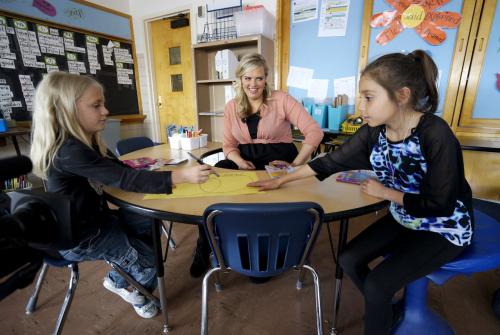A few weeks ago LeVar Burton launched a Kickstarter to relaunch Reading Rainbow online. The goal was to raise $1 million in 35 days to create new content and make it available to classrooms in need. Typically Kickstarters last 30 days but Burton wanted an extra five to ensure they met their goal. Tens of thousands of fans responded and they raised the million in less than twelve hours. Today over eighty thousand backers have raised more than $3.5 million. The success of the Reading Rainbow Kickstarter is exciting because of the opportunities it will create for a new generation of online viewers. Their success could pave the way for others to crowdsource creative and innovative education projects.
Donors Choose, a crowdsourcing platform for teachers, was founded in 2000 and has raised $225 million that supported over 400,000 projects. On their website teachers pitch projects that require specific technologies or even basic supplies. In this time of budget austerity few school districts have the budgetary flexibility to fund new or specialized projects. Donors Choose allows teachers to speak directly to the community and get the financial support to put their plans in action.
Benefits of the Crowdsourcing Technology
The crowdsourcing platform offers a few unique benefits when compared to other charities or government funding. Resources from crowdsourcing websites go directly into the classroom. Providing funds to teachers helps avoid extra costs. Teachers spend on average about $450 a year out of pocket on their students.
Crowdsourcing can help to lessen those costs and help students learn. The process of pitching a project to potential donors also requires the development of a theory, which strengthens the quality of the lesson. Particularly with regard to education technology charities and government have a habit of sending computers or other devices without reflecting on how and why they will help improve learning. Teachers who create a Donors Choose project must explain how they will use resources or technologies to help students learn. Developing that theory of learning increases the chances that students will benefit rather than placing donated iPads in a closet to gather dust.
Key Disadvantages to Traditional Funding Methods
Crowdsourced funding works well at a small scale when a project costs a few hundred dollars. The success of Reading Rainbow has demonstrated that larger ventures can also find the funding they need. But, overall the money raised from crowdsourcing is a drop in the bucket when compared with the entire primary and secondary school system. Schools spent about $640 billion during the 2009-2010 school year. Funding from crowdsourcing would have to increase dramatically before it could improve the overall quality of the education system.
Education politics expert Jeffrey Henig argues that Donor Choose has “hacked” classrooms, which could have negative long term consequences. Bureaucrats and elected officials make decisions in a way that reflects our democratic values and could resolve potential conflicts. A teacher who funds a project on their own also takes on responsibility for the content of the lesson that otherwise might not exist. Bypassing these traditional decision making processes could ultimately come back to bite teachers.
Donors Choose has the lofty and admirable goal of empowering teachers. However, donations alone can’t overcome barriers to comprehensive education reform. Despite these barriers, crowdsourced funding provides a much-needed source of innovation in education by directly providing teachers with the resources they need to support creative lesson plans.
The Brookings Institution is committed to quality, independence, and impact.
We are supported by a diverse array of funders. In line with our values and policies, each Brookings publication represents the sole views of its author(s).



Commentary
How to Reform Education with Crowdsourced Funding
June 16, 2014